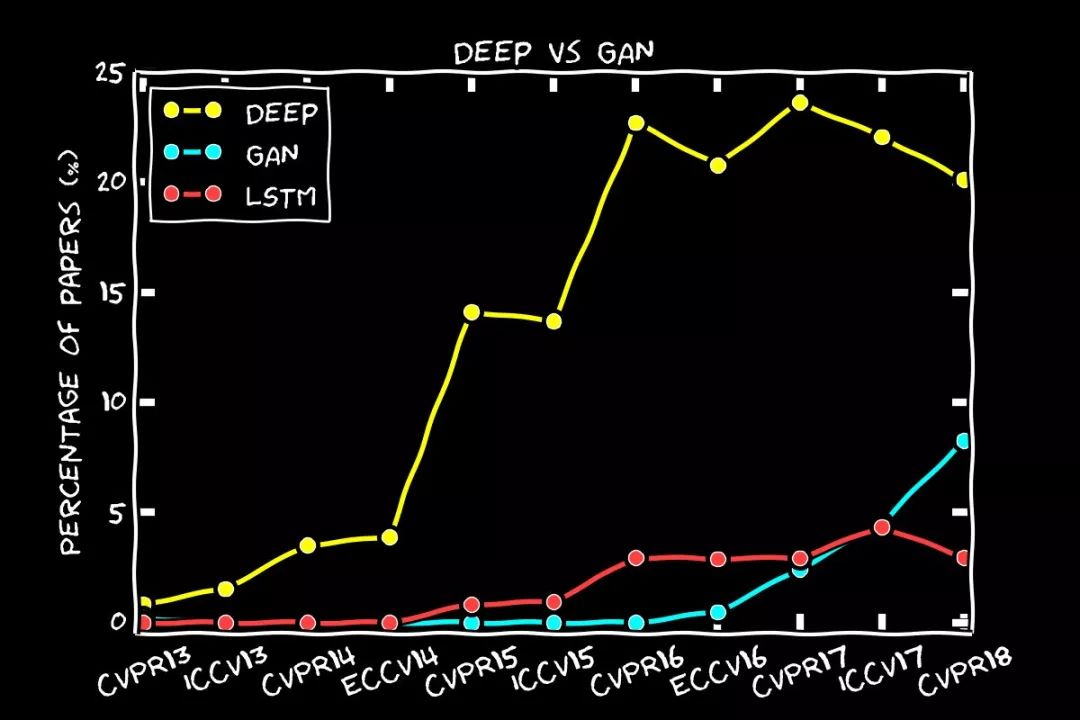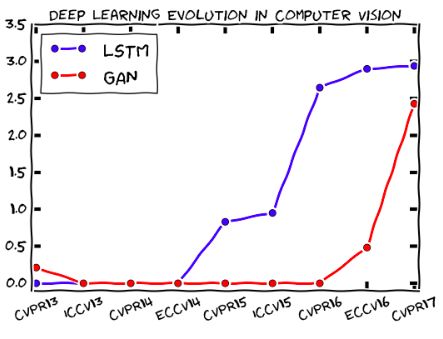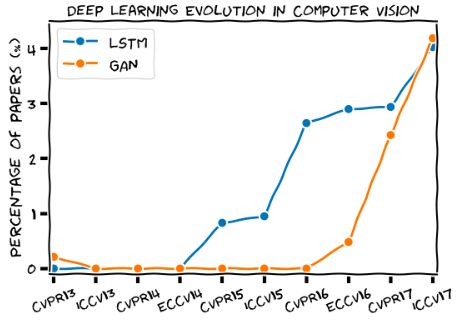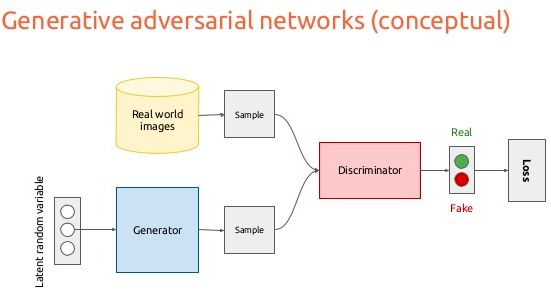The computer vision summit CVPR 2018 will be held soon. From the papers received, what kind of trends did this session show? You don't believe it, generating anti-network GAN is becoming a new "deep learning". It is also the time of the annual CVPR. When the list of accepted papers is published (click here to see a list of all papers), we have a lot more to do with the statistical trends. This time, Jordi Pont-Tuset, a research scientist at Google Research, made a statistic and looked at the development trend of deep learning based on the thesis topic. As a result, he found that the emergence of a strong anti-network (GAN) attack greatly replaced the trend of Deep Learning. The following figure shows the comparison of keywords GAN, Deep, and LSTM in the title of the thesis of CVPR 2018: It can be seen that ordinary "deep learning" is already on the decline, and the trend is obvious. According to Jordi Pont-Tuset, this is likely to be something that researchers have become accustomed to. At the same time, the GAN has risen significantly. There are 8% of paper titles that contain GAN (more than twice as many as in 2017). It can't be said to be a minority, but rather a direction that is quite weighty. In addition, LSTM has also experienced a decline, which may be an approach that more and more people are paying attention to and using Attention. "Deep learning" tends to saturate and GAN is soaring The rising trend of GAN did not begin with CVPR 2018. The following figure shows the frequency of GAN (and LSTM) appearing in the titles of the three major computer vision conference papers, CVPR, ICCV, and ECCV, from 2013 to 2017 during CVPR. The statistician is still Jordi Pont-Tuset. Although the absolute value of the percentage is not high (2.5% in 2017), it can be seen that GAN has started to fly from CVPR-16. This trend became even more apparent in the subsequent ICCV 2017. GAN has already surpassed LSTM in ICCV-17, and the percentage has reached 4%. Looking at “deep learning†again, the data from the top three CV summits shows that from the year of 2017 to 2016, although it is still growing (CVPR is slightly more), it has become saturated. Is GAN a new "deep learning"? It should be pointed out that the statistics here are just the keywords in the titles of the three major computer vision conferences that received the papers. As Jordi Pont-Tuset speculates, ordinary "deep learning" may well be known, and now it is in the field of research to start with a more detailed and concrete direction, such as GAN. Generative Adversarial Nets was proposed in Ian Goodfellow et al.'s 2014 paper "Generative Adversarial Nets" as a method of unsupervised learning by allowing two neural networks to learn from each other. The GAN structure is illustrated. Source: Slinuxer Generating a countermeasure network consists of a generator and a discriminator. The generation network takes random sampling from the latent space as input, and its output needs to imitate the real sample in the training set as much as possible. The input of the discrimination network is either the real sample or the output of the generation network. Its purpose is to distinguish the output of the generation network from the real sample as much as possible. The generation network must deceive the network as much as possible. The two networks confront each other and constantly adjust the parameters. The ultimate goal is to make the judgment network unable to determine whether the output of the generated network is true. Generating a countermeasure against the network is often used to generate real pictures that are confused. In addition, this method is also used to generate videos, three-dimensional object models, and the like. Now, the number of citations for this paper "Generative Adversarial Nets" has reached 3,363 times. In a Quora Q&A live broadcast, Yann LeCun said that the generation of adversarial networks is the most interesting idea in the past decade and one of the most anticipated algorithms for artificial intelligence. In an interview with Wu Enda last year, Ian Goodfellow once said that GAN is a kind of generative model. In fact, what GAN can do, many other generative models can also be done. If GAN training can be stabilized, it may even be like deep learning. Reliable, then GAN can really develop. If not, then GAN will be replaced by other methods. He spent about 40% of his time on stabilizing GAN. At least from this session of the CVPR, the situation that GAN was replaced is completely absent. Now there are many studies on GAN. Besides Ian Goodfellow's Google and his previous OpenAI, FAIR/NYU is also a big town. In fact, FAIR/NYU was the first to bring GAN into our vision and put forward LAPGAN, which was the first time that GAN had generated realistic HD images. It was also the first time that the media had been exposed. Another important camp is Berkeley + Nvidia, they focus on ultra-high-definition image and video, unsupervised translation, and so on. Berkeley's CycleGAN uses dual learning and combines the GAN mechanism to optimize the resulting image. Nvidia is adopting "progressive generation" technology to train GAN so that computers can generate 1024*1024 high-definition pictures, which can be almost as real ones. In addition to image generation, GAN applications have also been extended to NLP and Robot Learning. Ian Goodfellow said in a Q&A last year that GAN is a way to use reinforcement learning to solve modeling problems. "The difference with GAN is that the reward function is completely known and differentiable for behavior, reward is not fixed, and reward is a function of the Agent's strategy." Goodfellow said: "I think GAN basically can be said to strengthen Learn." The pin refers to the connection between the internal circuit of the integrated circuit (chip) and the peripheral circuit, and the pin constitutes the interface of the chip. According to the function, the pins of AT89S52 can be divided into four categories: main power supply, external crystal oscillator or oscillator, multi-function I/O port, and control, strobe and reset. Terminal Pins,Terminal Hardware Pin,High Precision Terminal Pins,Terminal Pins For Pcb Sichuan Xinlian electronic science and technology Company , https://www.sztmlch.com






